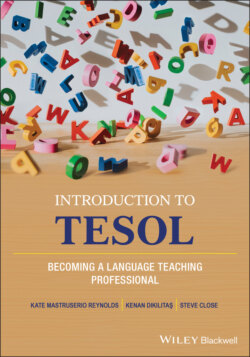Читать книгу Introduction to TESOL - Kate Reynolds - Страница 14
TESOL Voices Diverse Learners, Diverse Settings
ОглавлениеIn Kobe, Japan at Aitoku Gakuen Junior/Senior High School, uniformed ninth-grade students enter their English as a foreign language (EFL) class. Both the teacher, who speaks Japanese and English, and the teacher assistant, a native English speaker from Australia, greet the students in English as they enter the classroom. The teacher prepares her lesson by arranging the necessary paperwork and bringing up a video about air pollution in Japan. The teacher assistant engages the students in casual social conversation about how they feel, how their weekend was, and what they are up to personally. The students seem a bit embarrassed, but try to respond to the questions as well as they can. Some students respond in full sentences and provide some details about their lives; others provide one-word answers and look down to avoid more questions. Once the teacher begins the class, she reviews the meanings of the key vocabulary they are learning. Students provide definitions and examples of the vocabulary during a quick game, competing to see how many their team can get correctly in 2 min. After the vocabulary review, the students watch an 8-min video in English on air pollution in Japan. While they watch, they are asked to identify key information presented in the video. Next, they individually read an article about air pollution in English. Some students raise their hands to ask questions about a word or phrase and the teacher or teaching assistant approaches them to answer quietly. The teacher leads the whole class in discussion about the article by asking comprehension and opinion questions. She says, for example, “What is the greatest cause of air pollution today? How do you think you can reduce air pollution?” Students raise their hands to respond and several contribute their ideas of how they can reduce air pollution. Then, the teacher gives them a group project to investigate more ways people can reduce air pollution. Students are given small posters to describe and illustrate with their findings. Students will present their posters to the class.
At Citrus Park Elementary in Tampa, Florida, United States, a third-grade mixed class of native English speakers and English language learners (ELLs) listen to directions about their science experiment on erosion. First, they should discuss their prediction with their partner of what they think will happen when they drip the water into each tin. Both tins have a small incline. One tin has only loose soil at the top of the tin; the other has roots attached to the tin with the same amount of loose soil on top. Students are instructed to write down the prediction for the team after they discuss it. Next, they begin the experiment by dripping water using an eyedropper from a small beaker into two baking tins. The classroom fills with chatter as students give suggestions about where and how to drop the water. Some exclamations can be heard as the loose soil side creates an avalanche of loose soil in the bottom of the tin with only one dropper full of water. The students write down their observations on a graphic organizer. Next, they move to the roots and soil tin and begin dripping their water. They note in their graphic organizer that only a little of the soil erodes through the roots. The teacher circulates and reminds them to reread their predictions and check to see if they predicted correctly. They write in their graphic organizer whether their prediction was correct. They reflect on the experiment and discuss why they think the water eroded faster without roots. The teacher asks students to take their pans to the sink area, where they place the soil and roots in different buckets and the emptied trays in the sink. Once they are seated, the teacher asks the students what they predicted, observed, and what resulted. They discuss the reasons for the differences and connect this experiment to the erosion of a mountain.
In Melbourne Adult Migrant English Program (AMEP) in Melbourne, Australia, 12 adults ranging from 23 to 51 enter their English language class after leaving their children at the associated childcare center nearby. They are present to learn basic English language skills for participating in their jobs and conducting personal business in the community. Most of the students speak Mandarin or Arabic, but some are native speakers of Urdu or Vietnamese. One characteristic they all have in common is they are recent immigrants to Australia. Some of them arrived due to humanitarian reasons (e.g., political unrest, famine, or war); others for economic opportunities. They are greeted warmly by name by a teacher and three tutors and take their individual folder from the cabinet. Tutors sit down close by individuals or pairs and begin working with them. Each individual or small group is working on a different topic and level. In one pair, a tutor is presenting new vocabulary of items in a grocery store. The two older women say the vocabulary word aloud after the teacher. In a small group, the tutor is helping the students in a guided reading on conducting a job search. One student sits at a computer and takes an exam on business English terminology. The last group work with the teacher who is helping them with the academic reading skill of making inferences. Their class will last roughly 2 hr this evening, so they can pick up their children and return home at a reasonable hour.
All of these examples represent some of the variations of English teaching contexts and instruction. In each of these contexts, the learner population will be different. We will next talk about the acronyms used in the field and how they describe populations of learners; however, while we start here, we would like you to imagine the students in these different locales and keep the learners and learning at the forefront of your mind while reading.
